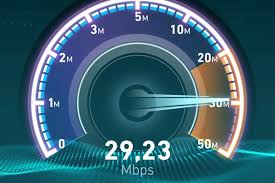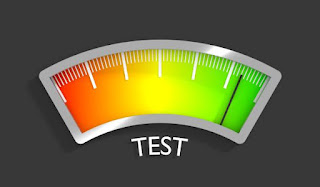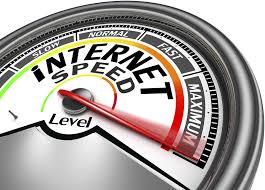Best Internet Speed Tests Of 2022: Test Your Connection ASAP
Your home internet speeds depend on the specific internet plan you signed up for from your ISP, but there are lots of reasons why your actual Wi-Fi speeds might be lower than you'd expect. For starters, speeds will drop as you move further away from your router, especially if there are a lot of walls and obstructions in between. Speeds can also fluctuate during hours of peak usage, or if your internet provider enforces data caps or throttles connections to help maintain overall network performance.
If you're curious to know your home's true internet speeds, there's an easy way to check. Running an internet speed test is quick and easy, and you've got lots of free options to choose from. You might even be able to run one from the same app that you used to set up your router. In most cases, running a test is as easy as pressing "Go," and won't take more than a minute or so.
A good Ping Speed Test will make it easy to see your current download speeds, upload speeds and latency (or ping) for whatever device you're running the test on -- but with so many options promising to do exactly that, which one should you trust?
One of our favorites is the Internet speed test, which has a strong reputation for consistency and for being one of the first speed tests on the web. Popularity aside, we like Internet for having everything a basic user needs from a speed test: accuracy, the ability to view your speed test history (when you create an account), a wide array of servers to connect to, and even a handy app for speed testing from your Android or iOS device. Incidentally, Internet speed test is also the one we use when we're testing Wi-Fi routers.
Internet's done a good job of keeping up with the times by adding new features and capabilities over the years. Most recently, the service released a video-specific speed test that measures your network's ability to handle 4K video streams. In addition to the website and the smartphone apps, Internet also has apps that you can run on Windows or on Mac. You can even run the Internet speed test on an Apple TV.
All of that said, Internet does display banner ads while you run basic speed tests. That's not surprising, but it might make a slight impact on your results depending on the strength of your connection at the time of the test.
Internet speed test is another great broadband test, and the interface is about as simple and straightforward as it gets. However, one of its biggest advantages is that it's owned by Netflix. That might seem odd at first, but it's actually what makes it a great pick for online streamers, because the test is structured around checking to see if your connection is strong enough to stream Netflix in maximum resolution without buffering.
While Fast.Com is a great tool for some, it won't be the most helpful test for all users. The basic interface is easy to use, yes, but it also lacks some of the advanced settings and metrics you'll find with other speed tests. Most notably, you can't specify which server you'd like to connect with for your test.
None of these speed tests are difficult to use, but the M-Lab Internet Speed Test is probably the easiest one to find. Short for Measurement Lab, the open-source M-Lab test was developed by a collection of computer scientists and academic researchers with Google's backing -- and it's the test that pops up whenever you type "internet speed test" into the Google search bar. Just click the blue "RUN SPEED TEST" button to see your download speed, upload speed and latency within a matter of seconds.
That's about as simple as it gets, because you won't need to bookmark it or remember exactly what it's called. There are no ads while you run the test, and the only data that gets shared with M-Lab is your IP address. Just know that the M-Lab test doesn't let you pick which server you'll use during the test, and it's only designed for internet speeds of up to 700 Mbps. If you're trying to speed test a gigabit connection, you'll want to turn elsewhere.
If you're looking for a test that offers a look not just at speeds, but at consistency, Speed is the way to go. Similar to Internet, the test interface does a great job of showing fluctuations in your upload and download speeds. Over time, that can make it easier to spot when something is amiss with your connection, especially since Speed lets you compare your results with previous tests. Its mobile-friendly website is great for running tests on your phone, too, allowing you to do a quick speed test on the go without downloading an app.
Speed isn't a perfect option, though. For starters, there's no option for manually selecting which server you connect with. And if home networking isn't your forte, the visualized data might seem more confusing or overwhelming than something like Fast.Com, which just gives you a number.
Testt is an internet speed test that runs entirely on HTML5 and PHP. What that means is that it doesn't require third-party software like Java or Flash to run your test, which can make for more accurate results. That also makes it a useful tool for comparing performance between different browsers. You can also create an account to track your internet speed for future reference or comparison.
It's not the most user-friendly tool, however. With a good deal of in-depth data, you'll have quite a bit of information to look through, much of which might not be relevant to you. The design is also a little ugly by speed test standards, and it takes a few clicks before you actually begin a test, which obviously isn't as streamlined as other speed tests that feature big "Go" buttons as soon as you load the page.
Speed test FAQs
What's a good internet speed?
The Federal Communications Commission defines broadband speeds as having downloads of at least 25 megabits per second and uploads of at least 3Mbps, but by the FCC's own speed guide, that's basically the bare minimum for things like streaming 4K video and sharing large files over the web.
Internet plans with multigig speeds as high as 2, 3 or even 5 gigabits per second (that's 5,000Mbps) are starting to emerge from a number of providers, including AT&T, Comcast, Frontier, Verizon Fios, Ziply Fiber and others, but plans like those are overkill for most homes, at least for now. Most ideal is a symmetrical internet connection with uploads that are just as fast as the downloads -- speeds of 100Mbps would be perfectly fine for most homes.
In addition to showing you the current upload and download speeds for whatever device you're running the test on, most internet speed tests will also give you a figure called ping, which is a latency measurement measured in milliseconds. Simply put, the ping number is the time that it took for your device to send a signal to whatever distant server you connected to during the speed test, and then receive a response. Think of it like a round-trip flight time for your internet connection.
Ping will go up if you're connecting to a server that's very far away, or if there's some sort of interference somewhere in the connection. Your ping might also rise slightly if you're connecting through something like a mesh router or a range extender, where your data needs to make multiple wireless jumps before reaching the modem.
In most cases, ping differences are pretty minor, enough so that you won't notice them without running a speed test. That said, you will start to notice high ping if you're trying to make split-second decisions in an online multiplayer game, and it can also cause annoying delays during video call conversations.
Like ping, jitter is measured in milliseconds, but instead of measuring the time it takes your device to send data to a remote server and receive a response, jitter describes latency differences between the flow of data to various client devices on your network. If jitter gets too high, it means that data isn't flowing to your device as efficiently as it probably should, and that can cause problems like buffering during streaming and video calls.
Can speed tests help improve my internet speeds?
Speed tests won't do anything to change the speed of your home's Wi-Fi network, but they're a great diagnostic tool -- a quick way to check how your network is performing in various spots around your home.
The best way to put speed tests to use is to run them on your phone or laptop in various rooms throughout your house. If you find a dead zone where speeds come crashing down, you might want to consider putting a range extender in the closest room to that dead zone where speeds are strong -- from there, it'll rebroadcast your Wi-Fi signal and potentially speed things up. If you find multiple dead zones in places where you'd like to connect, it might be time to upgrade your router. For the best whole-home Wi-Fi coverage, consider going with a mesh router that uses multiple devices.
What’s A Good Ping And How Do You Test Yours?
It’s Mike Muuss’ invention. His way of measuring lag time in milliseconds (ms), inspired by submarines. Data packets, from your computer or console, are pinged to the gaming server and back to you. The quicker your ping, the smoother and more competitively you can play online games, and the bigger the advantage you’ll have – players with higher pings than you will struggle to keep tabs on you and you’ll seem to hop around their screen.
Explore more about gaming What is lag?
It’s the time delay measured by the ping. The longer it takes to send and receive messages, the less they make sense. Lag can cause your character to jerk about while moving (fighting, driving, jumping) and your gameplay could freeze or rollback, if you haven’t already been disconnected from your online game because of lag. Perhaps you’ve heard gamers complain about latency? Well, this is what most people mean.
With practice and saint-like patience, you could get used to a lag. But it’s better to try to improve it so you can level up faster and have more fun. You’ll react quicker to what’s happening and land your skill shots on target when you’re seeing the most recent, live game play. You can also game on instinct, as you’ll see where you are on the map and what players are up to in real-time without having to imagine it all in advance.
For slower, turn-based games, lag isn’t the worst thing in the world because your moves can be less precise and perfect timing isn’t crucial. But high ping is a real killjoy for first person shooters (Call of Duty, Battlefield) where a delay could stop you getting the head shots you need to win the game. It also sucks the fun out of questing on multiplayer online battle arenas (League of Legends), playing real-time strategy games (Warcraft III: Reign of Chaos, North gard) or massively multiplayer online games (World of Warcraft, Rune Scape).
How to test your ping
For an accurate measure of your network performance, specific to the game and server you’re playing on, go to your game settings and find something like ‘Display performance stats’ or ‘Display network options.’ Most games, especially first person shooters, let you check your ping and some even colour code your connection, green being ideal. Yellow, average. Red, tragic.
Use an online ping test tool
Take your pick of the online tools and run a few tests at different times and in different rooms. Speed Test Net is one of the most popular for gamers. Or there’s Speed Smart to measure the ping to servers all over the world
For your first test, connect your computer or games console to your Hub with an Ethernet cable and measure your ping. Afterwards, unplug your cable and retake the test around your home to see how the numbers change. This will help you get a sense of your average ping, while showing you where your gaming set up could get the fastest connection. Ping in milliseconds also appears on our broadband speed test.




Comments
Post a Comment